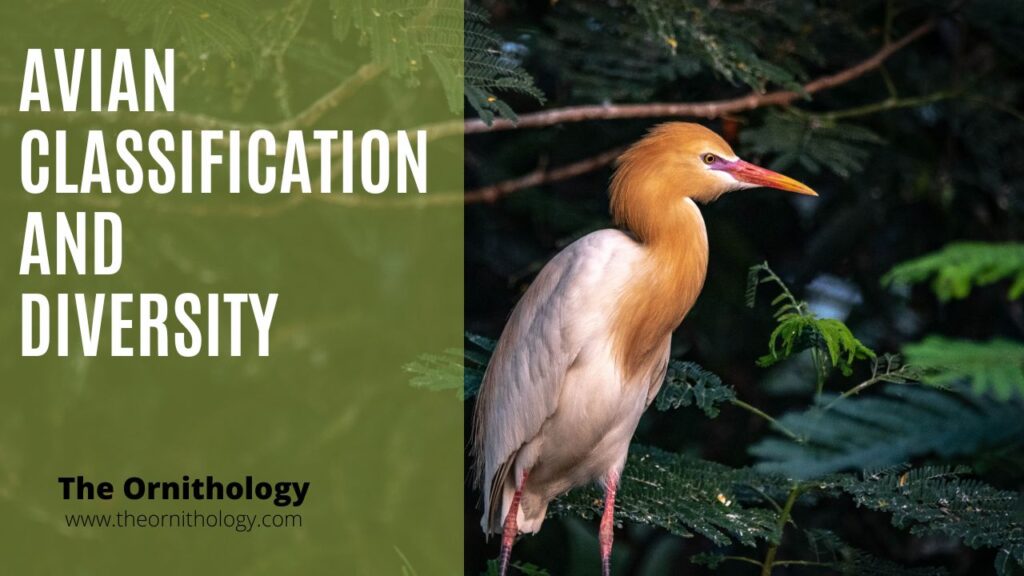Taxonomy: Categorizing Birds

Taxonomy is the science of classifying and categorizing living organisms based on their evolutionary relationships. Birds, belonging to the class Aves, are classified into various orders, families, genera, and species. This system of organization helps us understand the relationships among different bird species and their evolutionary history.
Major Bird Groups: Raptors, Passerines, Waterbirds, and more
Birds encompass a remarkable diversity of forms, behaviors, and ecological roles. Some major bird groups include:
- Raptors (Birds of Prey): This group includes eagles, hawks, falcons, owls, and vultures. Raptors are known for their keen eyesight, powerful talons, and hooked beaks, adaptations that enable them to hunt and feed on a variety of prey.
- Passerines (Perching Birds): Passerines make up the largest order of birds and include sparrows, finches, warblers, and many other songbirds. They are known for their specialized vocalizations, diverse diets, and adaptability to various habitats.
- Waterbirds: This group comprises birds that are highly adapted to aquatic environments, including ducks, geese, swans, herons, and shorebirds. Waterbirds have specialized bills for fishing, wading adaptations, and often engage in long-distance migrations.
- Gamebirds: Gamebirds include species like quail, pheasants, and grouse. They are often hunted for sport and have evolved unique behaviors and plumage to cope with predation and human pressures.
- Parrots: Parrots are known for their colorful plumage, strong beaks, and vocal abilities. They’re found in tropical and subtropical regions and exhibit complex social behaviors.
- Penguins: Penguins are flightless birds adapted for life in the water. They are excellent swimmers and are found primarily in the Southern Hemisphere, particularly in Antarctica.
- Hummingbirds: These tiny birds are known for their rapid wingbeats and iridescent plumage. They have a specialized diet of nectar and play a crucial role in pollination.
Global Distribution and Habitats
Birds are found on every continent and inhabit a wide range of ecosystems, from deserts to rainforests, mountains to oceans. Their adaptability allows them to thrive in diverse conditions. Some examples of avian habitats include:
- Forest Ecosystems: Birds like toucans, woodpeckers, and hornbills thrive in forest environments, using trees for nesting, food sources, and protection.
- Grasslands and Savannas: Many species of raptors, passerines, and gamebirds inhabit grassland habitats, where they find food, nesting sites, and open spaces for hunting.
- Wetlands: Waterbirds like ducks, herons, and egrets flourish in wetlands, which provide abundant food sources such as fish, insects, and aquatic plants.
- Coastal Environments: Shorebirds, gulls, and terns are adapted to coastal areas, utilizing the ocean’s resources and nesting on beaches or rocky shores.
- Arctic and Antarctic Regions: Penguins, snow petrels, and other cold-adapted species thrive in extreme polar environments.
The distribution and habitats of birds highlight their diverse ecological roles and the unique challenges they face in different environments. Studying these habitats helps us understand the interactions between birds and their surroundings, contributing to conservation efforts and our understanding of ecosystems.
Frequently Asked Questions (FAQ) – Avian Classification and Diversity
How are birds classified?
Birds are classified using a hierarchical system known as taxonomy. This system categorizes birds into orders, families, genera, and species based on their evolutionary relationships, characteristics, and traits.
What are some major bird groups?
There are several major bird groups, including raptors (birds of prey), passerines (perching birds), waterbirds, gamebirds, parrots, penguins, and hummingbirds. Each group has unique adaptations, behaviors, and ecological roles.
What defines raptors as birds of prey?
Raptors are birds known for their hunting abilities. They possess keen eyesight, strong talons, and hooked beaks. Examples include eagles, hawks, falcons, owls, and vultures.
Why are passerines important?
Passerines, also known as songbirds, are incredibly diverse and widespread. They play crucial roles in ecosystems, including pollination, seed dispersal, and insect control. Their varied songs contribute to biodiversity and are a delight for bird enthusiasts.
What makes waterbirds unique?
Waterbirds are adapted to aquatic environments, with specialized features like webbed feet and bills suited for catching fish and aquatic invertebrates. Ducks, herons, swans, and shorebirds are examples of waterbirds.
Are penguins really birds if they can’t fly?
Yes, penguins are birds, despite their flightlessness. They have adapted to life in the water, with streamlined bodies for swimming and strong flippers for propulsion. Penguins are excellent divers and are well-suited to their marine environments.
How do different habitats impact bird diversity?
Different habitats, such as forests, grasslands, wetlands, and coastal areas, offer unique resources and challenges for birds. Birds have evolved specific adaptations to thrive in various environments, leading to a rich diversity of species.
Do birds migrate across habitats?
Yes, many bird species undertake seasonal migrations to find suitable breeding and feeding grounds. They often traverse multiple habitats, relying on cues like celestial navigation and landmarks to guide them.
How can I identify birds in different habitats?
Learning about the key characteristics of various bird groups, such as bill shape, plumage color, and behavior, can help you identify birds. Field guides, online resources, and birdwatching clubs can provide valuable guidance.
Why is understanding avian diversity important for conservation?
Understanding the diversity of bird species and their roles in ecosystems is crucial for conservation efforts. Loss of habitat, climate change, and other human impacts can threaten bird populations. Protecting their habitats and understanding their ecological roles helps safeguard biodiversity.
Are there bird species that exist only in specific habitats?
Yes, many bird species have highly specialized habitat requirements. For instance, certain species of wetland birds are adapted exclusively to wetland environments and may struggle to survive outside of them.
How can I contribute to bird conservation and habitat protection?
You can support bird conservation by advocating for protected areas, reducing habitat destruction, participating in citizen science projects, and supporting organizations dedicated to bird conservation and habitat preservation.
What resources can help me learn more about bird diversity and habitats?
Field guides, online databases, nature documentaries, and birdwatching websites provide valuable information on bird diversity and habitats. Local nature centers and birdwatching groups are also great sources of knowledge and expertise.
